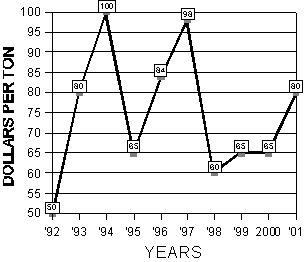Alfalfa Report
Yuma County, Arizona
August 27, 2001
Yuma County Office
2200 W. 28th Street, Ste. 102
Yuma, AZ 85364
(928) 726-3904
(928) 726-8472 FAX
Production Update:
PDF version, 41KB
Scald: Scald is damage that occurs to alfalfa associated with high temperatures and soil saturation. Scald is likely to occur when the soil is saturated for 30 hours or more and the temperature is greater than 100 F. Damage can occur at lower temperatures following a long period of saturation. Diseases caused by parasitic organisms do not progress as fast as scald, Injured plants become yellow and wilt within a week. The vascular tissue of the root or the entire root becomes brown. The roots usually emanate a putrid odor. Scald can be controlled by providing drainage, leveling fields, and avoiding standing water on ends of fields. Plants with foliage are much less susceptible to scald, so delaying irrigation until at least 4 inches of growth appears is probably the most effective control.
Insect Management: Empoasoa spp.m leafhopper occasionally cause economic damage in low desert alfalfa. These tiny yellowish-green insects cause a characteristic wedge-shaped yellow area on the outer end of leaflets. The leafhoppers inject salivary toxins that cause the yellowing and stunting. The yellowing can spread over the entire plant, giving the field a yellowish appearance. Adult leafhoppers migrate to alfalfa from vegetable fields and weeds. If damaging infestations are not controlled, toxin levels in the crown may persist to stunt and yellow subsequent cuttings. The treatment threshold is 5 to 10 leafhoppers per sweep. Treatments should be applied if counts reach 5 leafhoppers per sweep if alfalfa is 2 or more weeks away from harvest. Alfalfa scheduled to be harvested in 10 days to 2 weeks should be treated if counts reach 10 per sweep. Treat only the field edges where high leafhopper counts of a treatable magnitude are confined to the first 50 to 100 feet of the field margin.
Weed Control: The dinitroaniline herbicides, Prowl, Triflural
and Balan use the same mode of action but perform differently in alfalfa.
Trifluralin cannot be used preplant or it will cause unacceptable injury.
It also cannot be water run or it will fall out of suspension after 400
or 500 ft. Balan can only be used preplant and must be mechanically incorporated.
Prowl is not registered for alfalfa. If it was, it would be an excellent
treatment either water run or preplant incorporated.
| Market Summary |
High
|
Low
|
Average
|
Off grade
|
| Past 2 Weeks (August 13 to August 26, 2001) |
85
|
75
|
80
|
60-70
|
| Last Year (August 13 to August 26, 2000) |
70
|
60
|
65
|
50-60
|
10 Year Summary (August 13, to August 26, 1992-2001):

Issued in furtherance of Cooperative Extension work, acts of May 8 and June 30, 1914, in cooperation with the U.S. Department of Agriculture, James A. Christenson, Director Cooperative Extension, College of Agriculture and Life Sciences, The University of Arizona.
The University of Arizona is an equal opportunity, affirmative action institution. The University does not discriminate on the basis of race, color, religion, sex, national origin, age, disability, veteran status, or sexual orientation in its programs and activities.
Any products, services, or organizations that are
mentioned, shown, or indirectly implied in this web document do not imply
endorsement by The University of Arizona.
Information provided by:
Barry Tickes, btickes@ag.arizona.edu Extension Agent, Yuma County
Michael Ottman, mottman@ag.arizona.edu Agronomy Specialist
College of Agriculture, The University of Arizona.
Eric Natwick, etnatwick@ucdavis.edu UCCE Imperial County - Farm Advisor
University of California, Davis, CA.
Material written August 27, 2001.
Forages: Crop Mgmt | Soil Mgmt | Irrigation | Alfalfa Reports | Insects | Diseases | Weeds | Pesticides
Home | Other Crops | Forages
For more Arizona Production Ag Information:
Home | Cotton | Veggies| Forages | Grains | Citrus | Crop x Crop | Insects | Diseases| Weeds | Pesticides | News | Weather | Research | Photos | Contacts | General Info. | Site Map
Copyright © 2001 University of Arizona,
College of Agriculture and Life Sciences
Webmaster: Al Fournier (fournier@ag.arizona.edu)